Your Cart is Empty
Shop
We are a brand born of an obsession with performance, a belief in good science, and a knack for invention.
Read our story.
We are a brand born of an obsession with performance, a belief in good science, and a knack for invention.
Read our story.

Good Science
We define it as a combination of discerning research and real world results.
We define it as a combination of discerning research and real world results.

How to grow Bucephalandra
November 08, 2021 5 min read

Are Bucephalandra hard to grow?
Bucephalandra are endemic to Indonesia and are found on the island of Borneo. They are slow-growing, hardy and are especially well suited to grow attached to hardscape (rock / wood), as in the picture above and below. They can also be grown on the substrate as long as the rhizome is not buried. Due to their flexible light demands, they can be grown in shaded portions of the tank, or in full lighting.
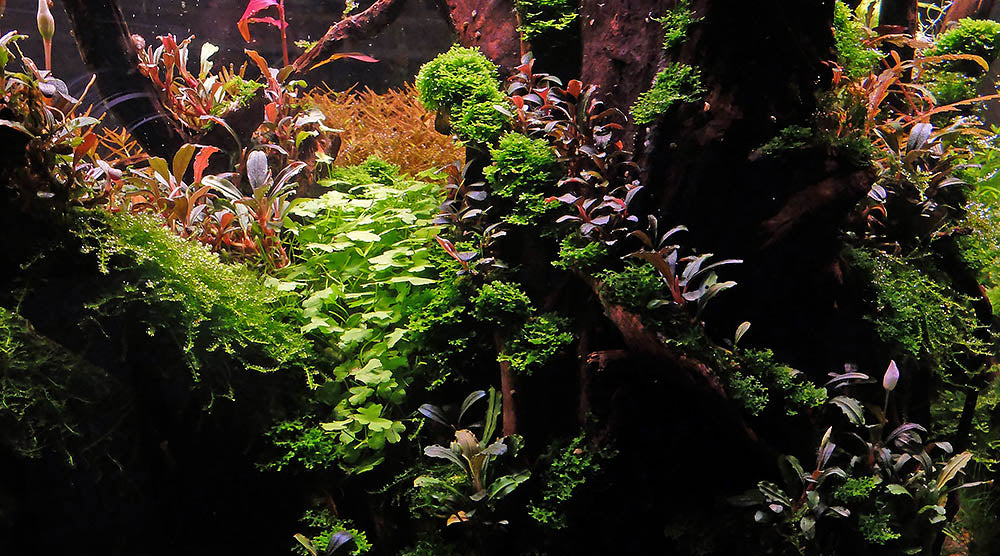
Buceps belong to a genus of flowering rheophyte that grows with a creeping rhizome; they come in a large variety of leaf shapes and colors. A distinctive feature of all Bucephalandra are bright spots on the leaves. Many are iridescent, reflecting brilliant colors when viewed at particular angles.
Bucephalandra species face less stress/melting issues with cooler water, even though growing them in discus temps is still possible (above 80f/27c). For those living in the tropical belt, having chillers or at least fans is beneficial. They do better in tanks with good flow.

So, why is my Bucephalandra melting?
Uncycled planted tanks with high levels of ammonia or organic waste leads to melting; this is common among beginners who do not cycle their tanks fully before planting.
Melting Buceps is not a "normal" situation. Bucephalandra species do better in stable tanks with matured biological systems. Especially when facing transport stress or stress from being moved between tanks of different parameters, having cool, clean water, and supplementary CO2 is important to prevent melting.
Bucephalandra are hardy plants that can survive in planted tanks without CO2 injection or much fertilization. However, to grow them to their best, they do better with good flow and CO2. Having good growth parameters also make them much more resistant to algae.
Depending on species, their growth rates can be a bit different. Slower species can produce as few as 1 leaf every 3 weeks, while faster growing species can produce 2 leaves per week in good conditions.

How to grow Bucephalandra in an aquarium?
Key success factors
- Slightly cooler water (71f/21c-79f/26c).
- Clean, well filtered water with good flow.
- Stable, biologically matured tank environment.
- Some hardness (GH/KH) is helpful. (5dGH and above). We use APT SKY for all tanks with Bucephalandra.
- Adequate CO2/Fertilization brings out coloration, speeds up growth.
To learn more about GH, click here.
To understand why long term stability is important for Bucephalandra read this post on preventing holes and deterioration of older leaves here.
Light & Algae Control
Is Bucephalandra a low light plant?
Bucephalandra grows well under lower levels of lighting. Indeed growing them under CO2/nutrient rich waters but with subdued lighting <50umols of PAR makes for easy management.
As they grow very slowly, they are very vulnerable to algae. You can grow them in high lighting (100+umols ) but you need to keep your planted aquarium very clean and your Buceps must be healthy to remain algae free. This means being consistent about water changes, clearing organic debris and being on point on pruning. The algae sectiondetails how to maintain an algae free tank.
In tanks that have overly turbulent CO2 misting and violent flow, Bucephalandra in the path of flow become more vulnerable to black brush algae (BBA). This is one instance where too much flow can be counter-productive. Find ways to re-direct the flow or get more gentle distribution of flow if you find that Bucephalandra in path of flow are the ones that consistently get BBA.
If you have consistent algae issues with Bucephalandra, it most likely stems from having high organic waste levels in the tank (having high fish load, but an immatured bio-filter for example) or that the plants are not getting the parameters they require (lack of flow, key nutrients are common reasons).
If the patch of Bucephalandra is infested with algae, you can spot treat the area by spot dosing APT Fix directly onto the algae spot using a dropper.

Bringing out Colors
Firstly, not all Bucephalandra are strongly colored. Most are green-based. Many species that develop colored submerged leaves have greenish emersed leaves, so using a knowledgeable dealer is important.
For many species, the new leaves may have strong coloration, but as the leaves age they fade to greenish tones. Hence to get color, it is more effective to grow them in clumps where there are a few new leaves present at anyone time. This also means that having faster growth rates; providing good growth conditions is important (CO2 & flow being paramount).
Many Bucephalandra are iridescent; meaning that they are good at reflecting certain colors; especially when viewed at a certain camera angle. Using colored T5 tubes or mix RGBs with with LEDs allow more colors to be reflected - use your individual judgment as to how much colored lighting is used; too much looks artificial. Generally speaking, flat white T5 tubes & plain white LEDs seldom have a wholesome light spectrum profile (all almost universally lack adequate red spectrum), and do not display colored plants to their best.

Which are the most colorful Bucephalandra species?
Some colored variants to try:- Brownie ghost 2011/2012 - develops red new leaves that turn purple over time
- Brownie blue - red new leaves that turn purplish metallic
- Silver powder
- Phoenix
- Jade
- Catherine


Color change after planting
Most Buceps are sold- and bought in emersed form, and most emersed Buceps have green leaves even when their submerged forms have far more color. In this picture, we show a batch of recently submerged Bucephalandra - the emersed leaves are green in color (red arrows) and new sprouts of submerged form leaves are darker and more colorful (blue arrows). Depending on the tank parameters, the newly submerged plants may sacrifice some of the older emersed growth, while the younger emersed grown leaves fully convert to submerged growth forms. This conversion process can be stressful for the plant - if tank conditions are poor, this can lead to wide-spread melting and excessive loss of existing leaves.

How do you plant Bucephalandra in aquariums?
Separating clumps
If your Bucephalandra supply comes from Indonesian farms, they often come in large mats or clumps. Bucephalandra grows much better, similar to all other plants, when they have adequate free space - separating clumps into individual plants will allow for much faster, healthier propagation as each plant has better access to water flow and light.
Separating clumps also allows one to clear off dead/old leaves and rhizomes, making space for new growth. Clearing off debris and old growth is important in keeping Bucephalandra clean and algae free - which is one of the top priorities in growing Bucephalandra well over the long term.
When picking apart the clump, make sure that individual rhizomes are not too short; portions longer than 1.5 inches work well (shorter for very small species). Often bare rhizomes will sprout new leaves as well if they are healthy and growth conditions are good - just stick them to rock/wood surfaces.
In the picture below, Horticulturist Sera Brown carefully picks apart individual Bucephalandra pieces.
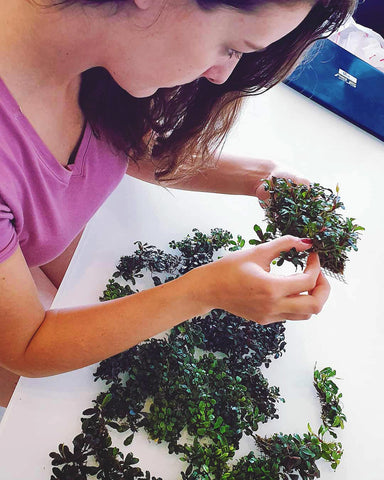
Bucephalandra varietals- Allan Lau
Many of the Bucephalandra species in the trade have not been assigned formal scientific names. The circle of more reputable dealers have a high accuracy with their trade names though. These trade names are created based on the names of regions or rivers where they were collected (e.g. Lamandau [central kalimantan], Sintang [west kalimantan]). The names are also created according to the coloration and shape of the leaves (e.g. Dark wave, Super blue, Brownie purple). These are sample pictures of various Bucephalandra species available in the aquarium trade from my local Bucephalandra dealer Lau Allan; who we get most of our Buceps from. His photos are taken from tanks with only plain white bulbs.
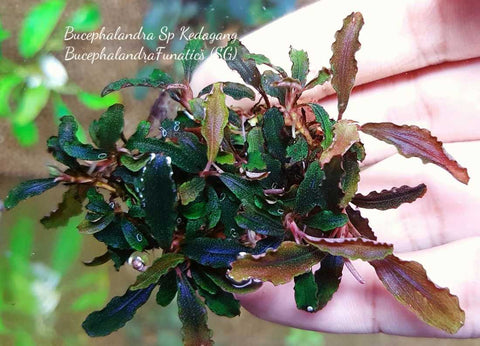
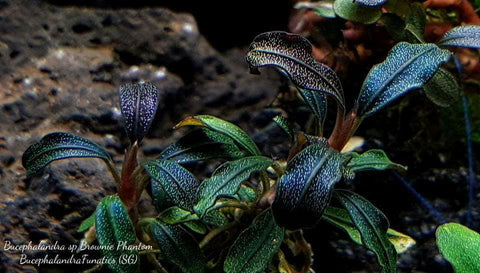

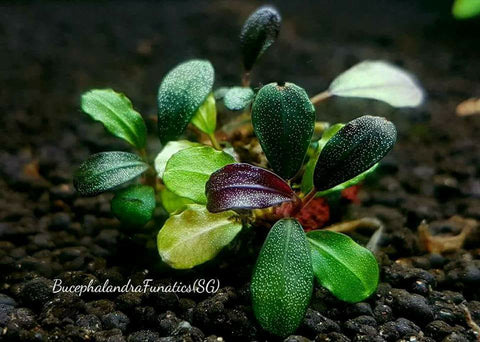


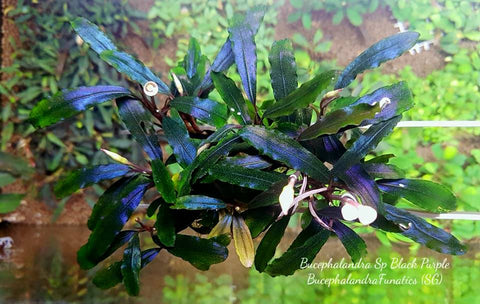

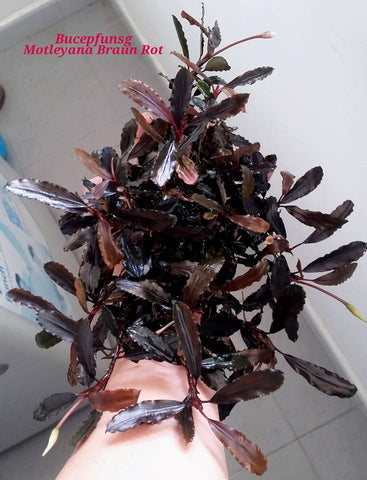

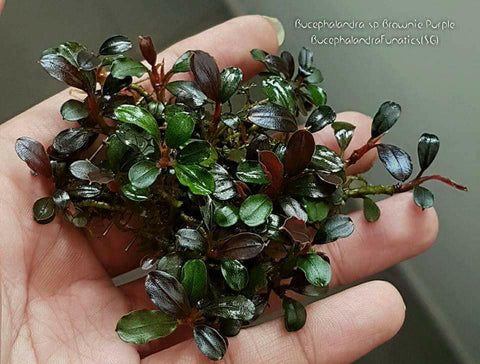
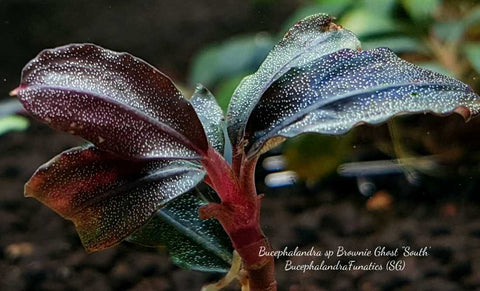
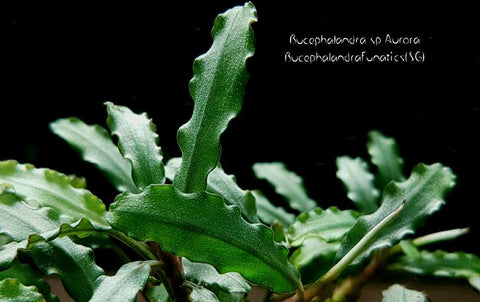

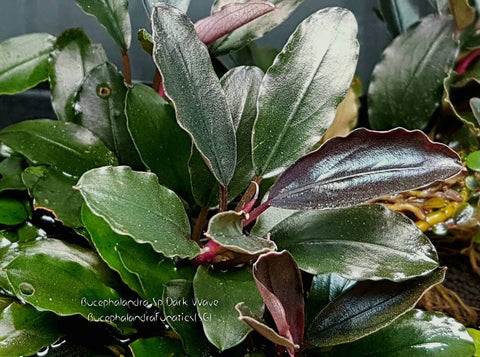
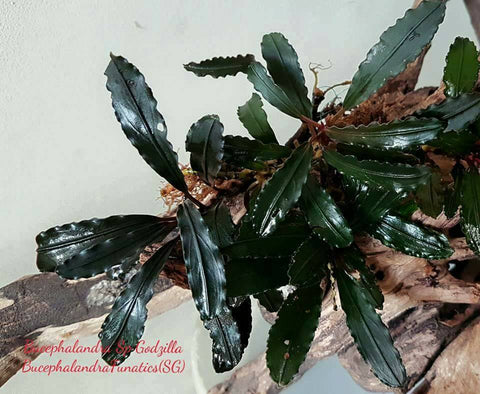
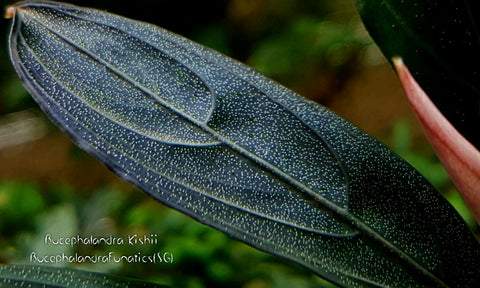
unlock your true potential
Grow anything, defeat algae, create amazing aquascapes






















